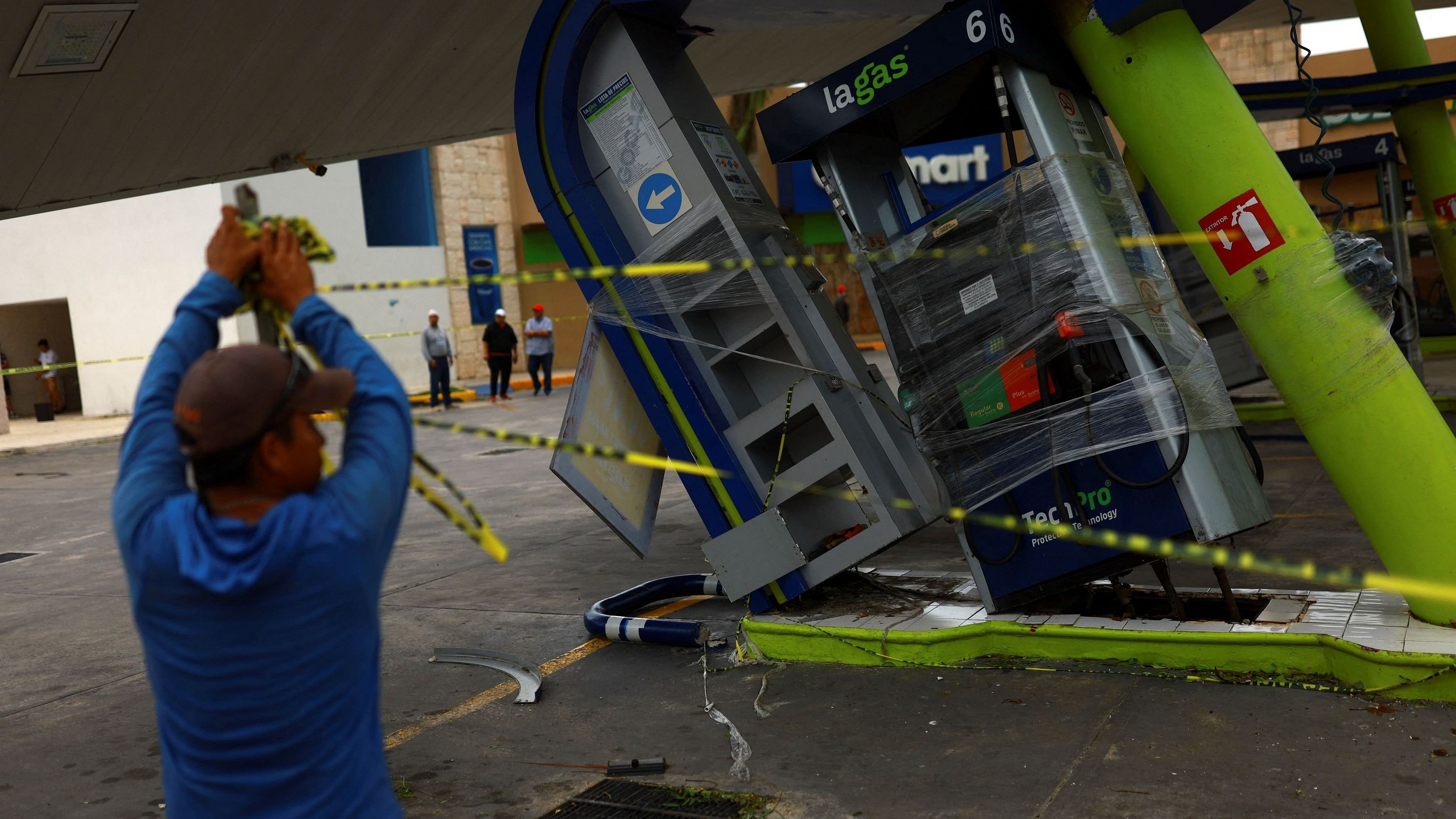
A person holds caution tape around a gas station that was hit by Hurricane Beryl, which has now downgraded to tropical storm, in Puerto Aventuras, Mexico, July 5, 2024.
Credit: Reuters Photo
Texas was bracing for Tropical Storm Beryl as it emerged in the Gulf of Mexico on Friday evening and a hurricane watch was issued for the state's southern coast.
Hours earlier, the storm made landfall in Mexico as a Category 2 hurricane. Damaging winds and storm surge battered the Mexican coast, leaving snapped trees and power outages in its wake. Beryl, which then weakened to a tropical storm, was expected restrengthen this weekend as it moves over the Gulf toward Texas.
In the past week, the storm flattened islands and killed nine people in Grenada and Jamaica.
Here are key things to know about the storm:
--Beryl was entering the Gulf of Mexico on Friday evening, maintaining maximum sustained winds of 65 mph with higher gusts, the National Weather Service said.
-- Storm surge could raise water levels by as much as 2 to 5 feet.
-- The weather service issued a hurricane watch and a storm surge watch Friday afternoon for the southern Texas coast, from the mouth of the Rio Grande to Sargent, a community roughly 65 miles southwest of Houston. Texas issued a disaster declaration for 40 counties before a possible landfall Monday.
-- Mexico's meteorological service issued a hurricane watch for the northeastern coast of Mexico from Barra el Mezquital to the mouth of the Rio Grande.
-- Power outages were reported in the state of Yucatan earlier Friday as Beryl moved there from Quintana Roo, officials said. A tropical storm warning was in effect Friday for part of the peninsula's coast, from west of Cabo Catoche to Campeche.
-- Although Beryl weakened slightly as it crossed the Yucatan Peninsula, the storm is expected to reintensify over the southwestern Gulf of Mexico late Friday. Then it will probably move toward northeastern Mexico and southern Texas.
The storm has left destruction in its wake.
Forecasters were predicting that Mexico would be hit twice by the hurricane. It crossed the Yucatan Peninsula on Friday, and then, after traversing the Gulf of Mexico over the weekend, it was expected to reach the coast of the northern state of Tamaulipas, where a hurricane watch was in effect.
Officials in Texas were already preparing for the storm's possible landfall Monday morning as a hurricane watch was issued for the state's southern coast Friday afternoon.
Lt. Gov. Dan Patrick of Texas, who is serving as acting governor while Gov. Greg Abbott travels out of the country, issued a disaster declaration for 40 counties expected to experience impacts from the storm. The declaration enables state resources to assist in local preparation and recovery efforts.
Patrick said that emergency response teams were paying close attention to areas at greater risk, starting from Brownsville, Texas, all the way to the Louisiana border.
"Everyone along the coast should be paying attention to this storm," Patrick said. Likely flooding and storm surge remained major concerns, state officials said.
In Mexico, no injuries or deaths had been reported as of Friday evening, Laura Velázquez Alzúa, Mexico's coordinator of civil protection, said at a news conference. More than 2,100 people who took refuge in shelters were already returning to their homes. No major flooding was reported, she said, although crews in Quintana Roo were working to restore power outages affecting 20% of the population. "Normality is being reestablished," Velázquez Alzúa said. "The damages are minor."
In Tulum, a resort town, the storm's impacts were being felt unevenly. Some tourists strolled along the roads to observe the damage, mostly downed trees and utility poles.
Nearby, about 300 low-income residents lined up at a mobile kitchen set up by the Mexican army.
"I didn't buy any groceries or anything," said María Cruz de la Cruz, 39, referring to her lack of preparation for Beryl. "There is no money to buy things."
Early Friday, Mexico's meteorological agency said the storm had dumped between 6 and 10 inches of rain in Campeche, Quintana Roo and Yucatan. It reported wind gusts as high 135 mph and a storm surge of more than 10 feet along the coasts of Quintana Roo and Yucatan.
Earlier this week, at least nine people were killed as the storm lashed parts of Grenada, then Jamaica and the Cayman Islands.
Beryl made landfall on Monday in Grenada, where officials said about 98% of the buildings on Carriacou and Petite Martinique, home to 9,000 to 10,000 people in total, had been damaged or destroyed, including Carriacou's main health facility.
"We have to rebuild from the ground up," said Dickon Mitchell, the prime minister of Grenada.
Aid was just starting to arrive by boat on Carriacou on Friday, after rough seas and destroyed roads complicated response efforts.
The storm then churned along toward Jamaica, where on Wednesday, heavy rain and destructive winds left their mark. Beryl was the strongest storm to approach the island in over a decade. Over half of the customers of the country's main power provider remained without electricity Friday, the company said.
The storm also ripped away a section of the jet bridge roof of Jamaica's main airport.
Residents in the Cayman Islands were largely breathing a sigh of relief after Hurricane Beryl passed by at Category 3 strength on Thursday morning without making landfall. There were no reports of significant damage, injuries or fatalities.
This hurricane season is expected to be busy.
Forecasters have warned that the 2024 Atlantic hurricane season could be much more active than usual.
In late May, the National Oceanic and Atmospheric Administration predicted 17 to 25 named storms this year, an "above-normal" number and a prediction in line with more than a dozen forecasts earlier in the year from experts at universities, private companies and government agencies. Hurricane seasons produce 14 named storms, on average.